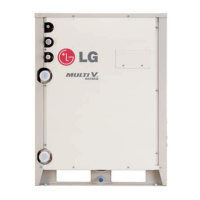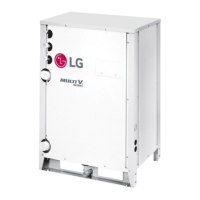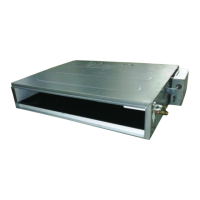54
MULTI V Water IV System Installation Manual
Due to our policy of continuous product innovation, some specifications may change without notification.
©LG Electronics U.S.A., Inc., Englewood Cliffs, NJ. All rights reserved. “LG” is a registered trademark of LG Corp.
REFRIGERANT PIPING INSTALLATION
No Pipe Size Substitutions
Use only the pipe size selected by the LATS Multi V pipe system de-
sign software. Using a different size is prohibited and may result in a
system malfunction or failure to operate.
Obstacles
Refer to Figure 27. When an obstacle, such as an I-beam or concrete
T, is in the path of the planned refrigerant pipe run, it is best practice
to route the pipe over the obstacle. If adequate space is not available
to route the insulated pipe over the obstacle, then route the pipe under
the obstacle. In either case, it is imperative the length of the horizontal
section of pipe above or below the obstacle be a minimum of three (3)
times the longest vertical rise (or fall) at either end of the segment.
Copper Expansion and Contraction
Under normal operating conditions, the vapor pipe temperature of a
Multi IV system can vary as much as 160°F. With this large variance
in pipe temperature, the designer must consider pipe expansion and
contraction to avoid pipe and fitting fatigue failures.
Refrigerant pipe along with the insulation jacket form a cohesive
unit that expands and contracts together. During system operation,
thermal heat transfer occurs between the pipe and the surrounding
insulation.
If the pipe is mounted in free air space, no natural restriction to
movement is present if mounting clamps are properly spaced and
installed. When the refrigerant pipe is mounted underground in a
utility duct stacked among other pipes, natural restriction to linear
movement is present. In extreme cases, the restrictive force of
surface friction between insulating jackets could become so great
that natural expansion ceases and the pipe is “fixed” in place. In this
situation, opposing force caused by change in refrigerant fluid/vapor
temperature can lead to pipe/fitting stress failure.
The refrigerant pipe support system must be engineered to allow free
expansion to occur. When a segment of pipe is mounted between
two fixed points, provisions must be provided to allow pipe expan-
sion to naturally occur. The most common method is the inclusion of
expansion Loop or U-bends as shown in Figure 28. Each segment
of pipe has a natural fixed point where no movement occurs. This
fixed point is located at the center point of the segment assuming the
entire pipe is insulated in a similar fashion. The natural fixed point
of the pipe segment is typically where the expansion Loop or U-bend
should be. Linear pipe expansion can be calculated using the
following formula:
LE = C x L x (T
r
– T
a
) x 12, where:
LE = Anticipated linear tubing expansion (in.)
C = Constant (For copper = 9.2 x 10
-6
in./in.°F)
L = Length of pipe (ft.)
T
R
= Refrigerant pipe temperature (°F)
T
a
= Ambient air temperature (°F)
12 = feet to Inches conversion (12 in./ft.)
1. In Table 45, find the row corresponding with the actual length of
the straight pipe segment.
2. Estimate the minimum and maximum temperature of the pipe.
In the column showing the minimum pipe temperature, find the
anticipated expansion distance. Do the same for the maximum
pipe temperature.
3. Calculate the difference in the two expansion distance values.
The result is the anticipated change in pipe length.
Example:
A Multi V system is installed and the design shows that there is
a 130 feet straight segment of tubing between a Y-branch and an
indoor unit. In heating, this pipe transports hot gas vapor to the
indoor units at 120°F. In cooling, the same tube is a suction line
returning refrigerant vapor to the water source unit at 40°F. Look up
the copper tubing expansion at each temperature and calculate the
difference.
Vapor Line
Transporting Hot Vapor: 130 ft. pipe at 120°F = 1.54 in.
Transporting Suction Vapor: 130 ft. pipe at 40°F = 0.52 in.
Anticipated Change in Length: 1.54 in. – 0.52 in. = 1.02 in.
Liquid Line
The liquid temperature remains relatively the same temperature; only
the direction of flow will reverse. Therefore, no significant change in
length of the liquid line is anticipated.
When creating an expansion joint, the joint height should be a
minimum of two times the joint width. Although different types of
expansion arrangements are available, the data for correctly sizing
an expansion loop is listed in Table 46. Use soft copper with long
radius bends on longer runs or long radius elbows for shorter pipe
segments. Using the anticipated linear expansion (LE) distance
calculated, look up the expansion loop or U-bend minimum design
dimensions. If other types of expansion joints are chosen, design per
ASTM B-88 Standards.
Figure 27: Installing Piping Above or Below an Obstacle.
Above an obstacle.
Below an obstacle.

